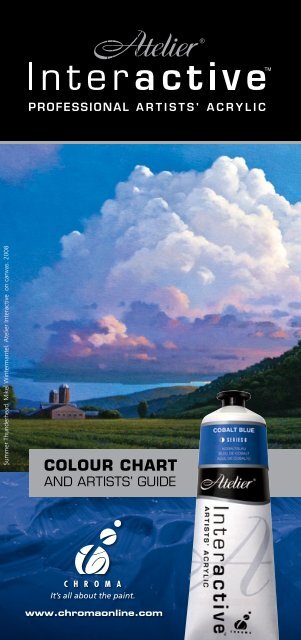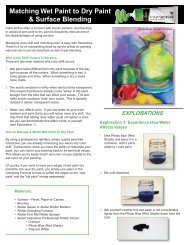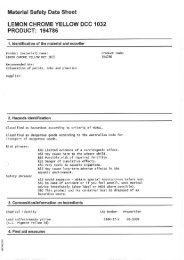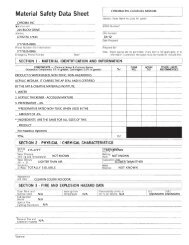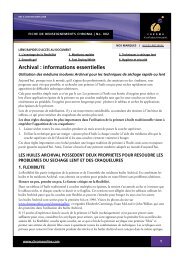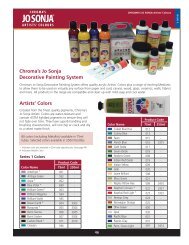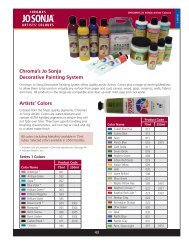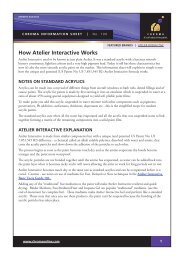Atelier Interactive Colour Chart 2.34 MB - Chroma
Atelier Interactive Colour Chart 2.34 MB - Chroma
Atelier Interactive Colour Chart 2.34 MB - Chroma
Create successful ePaper yourself
Turn your PDF publications into a flip-book with our unique Google optimized e-Paper software.
Summer Thunderhead. Mikel Wintermantel. <strong>Atelier</strong> <strong>Interactive</strong> on canvas. 2008<br />
<strong>Colour</strong> <strong>Chart</strong><br />
and artists’ Guide<br />
www.chromaonline.com
Market day Vence. Mitch Waite. <strong>Atelier</strong> <strong>Interactive</strong> on canvas.<br />
CONTENTS<br />
2 ................... introducing atelier interactive<br />
3 ....... atelier interactive Painting techniques<br />
4 ............. using a Fine Mist Water sprayer<br />
5 ............... Ordinary Fast drying techniques<br />
6 .......... slow drying Wet-in-Wet techniques<br />
7 .................................... atelier Mediums<br />
10 ........................................... Varnishes<br />
11 ....................... atelier interactive Q & a<br />
13 ...................................... <strong>Colour</strong> range<br />
Learn More Online<br />
THE MOST VERSATILE ACRYLIC!<br />
The unique <strong>Interactive</strong> formula gives you more creative<br />
freedom than any other paint - offering the speed and<br />
simplicity of an acrylic with the option of more blending time<br />
when you need it.<br />
Simply paint in your usual way<br />
for traditional fast drying acrylic<br />
techniques and if you want more time<br />
to blend, use a water sprayer to keep<br />
the paint open and workable for as<br />
long as you like; even dry paint can be<br />
reactivated with Unlocking Formula.<br />
<strong>Atelier</strong> <strong>Interactive</strong> is a professional<br />
quality artists’ acrylic paint. It is<br />
highly pigmented and lightfast with a<br />
smooth buttery consistency that dries<br />
to a beautiful matte/satin finish.<br />
INTERACTIVE’S UNIQUE BENEFITS<br />
• Fast drying acrylic techniques<br />
• Oil like wet-in-wet blending<br />
• Dilute for water colour effects<br />
• Highly pigmented and lightfast<br />
• Smooth buttery consistency<br />
• Minimal wet to dry colour shift<br />
• Extensive range of 75 colours<br />
• Use with <strong>Atelier</strong> Mediums for added versatility<br />
• Available in 80ml, 250ml and selected 1 litre jars<br />
the <strong>Chroma</strong> website has extensive product information<br />
& great advice on how to paint with atelier interactive. www.chromaonline.com<br />
The Fine Mist Water<br />
Sprayer is your<br />
most important<br />
tool when you<br />
want to keep your<br />
paint wet for more<br />
blending time.
atelier <strong>Interactive</strong> Painting techniques<br />
<strong>Atelier</strong> <strong>Interactive</strong> has been designed to give you greater control over<br />
the painting process. It does this by allowing you to chooSe when<br />
you want your paint to dry fast and when you want some more time<br />
to blend with wet paint.<br />
To achieve this amazing level of control all you need to do is<br />
learn how and when to use a water sprayer.<br />
How it works?<br />
As <strong>Atelier</strong> <strong>Interactive</strong> dries it doesn’t<br />
form a skin like other acrylics do, which<br />
means it can readily absorb more water<br />
to replace what has evaporated. After<br />
the paint has dried it gradually cures and<br />
becomes permanent and waterproof.<br />
Note: <strong>Atelier</strong> <strong>Interactive</strong> contains no<br />
retarder so it will dry quickly if not kept<br />
wet with a water sprayer.<br />
Getting Started<br />
The best way to try <strong>Atelier</strong> <strong>Interactive</strong> is<br />
to get the 12 x 20ml set or you could buy<br />
some 80ml tubes and use them along<br />
with your other paints. <strong>Atelier</strong> <strong>Interactive</strong><br />
can be mixed with other acrylics but to<br />
experiment with the extended blending<br />
and rewetting techniques you have to<br />
use just the <strong>Atelier</strong> <strong>Interactive</strong> colours.<br />
FaSt DryIng<br />
If you want to use <strong>Atelier</strong> <strong>Interactive</strong><br />
like an ordinary acrylic then just paint<br />
as usual and your artwork will dry off<br />
quickly; simply don’t spray it!<br />
More tIMe to BlenD<br />
When you want more wet-in-wet<br />
blending time use a Fine Mist Water<br />
Sprayer or even just a damp brush to<br />
re-wet your painting and keep working<br />
wet-in-wet for as long as you like!<br />
The 12 x 20ml Tube<br />
Set is a cost effective<br />
way to try <strong>Atelier</strong><br />
<strong>Interactive</strong>.<br />
using a Fine Mist Water Sprayer<br />
The water sprayer can be a very powerful tool,<br />
allowing artists to control the drying speed of<br />
their paint. When you need more time for wet<br />
blending a light misting of water can keep <strong>Atelier</strong><br />
<strong>Interactive</strong> wet for as long as you like.<br />
To use a water sprayer successfully follow<br />
these simple instructions.<br />
What kind of sprayer?<br />
The sprayer must deliver a FINe mist of<br />
water. We recommend the <strong>Atelier</strong> Fine Mist<br />
Water Sprayer.<br />
Note: For larger works you may need to<br />
up‑size your sprayer in which case be sure to<br />
get one that delivers a fine mist of water and<br />
not a jet of heavy droplets.<br />
When to spray?<br />
As the paint starts to dry you will feel your brush begin to drag.<br />
This means it is time to spray if you want to keep the paint wet<br />
and workable.<br />
How to spray?<br />
hold the bottle back about 30cm from the painting and<br />
lightly mist the area you want to keep wet. The painting<br />
surface should not be physically disturbed by the water<br />
droplets. If you are getting large droplets or big dribbles<br />
then you are spraying too much.<br />
What if the paint won’t re-wet?<br />
After the paint has just dried it can still be reactivated with<br />
water but after about an hour, depending on climate and<br />
paint thickness, you will need to use Unlocking Formula<br />
in your water sprayer to re‑wet the paint.<br />
The Using <strong>Interactive</strong> With Mitch<br />
Waite DVD is a great way to<br />
learn how to paint with <strong>Atelier</strong><br />
<strong>Interactive</strong>.<br />
The DVD set also comes with a<br />
bonus Using <strong>Interactive</strong> With<br />
Keith Norris DVD.<br />
These two DVDs and other<br />
videos can be watched on the<br />
<strong>Chroma</strong> website and YouTube.<br />
Learn More Online<br />
the <strong>Chroma</strong> website has extensive product information<br />
& great advice on how to paint with atelier interactive. www.chromaonline.com
ordinary Fast Drying acrylic techniques Slow Drying Wet-in-Wet techniques<br />
<strong>Atelier</strong> <strong>Interactive</strong> is very straightforward<br />
to use for “normal” acrylic techniques;<br />
just don’t use a water sprayer and the<br />
paint will dry quickly.<br />
It behaves much the same as any other artists’<br />
quality impasto acrylic with good consistency,<br />
pigmentation and brushability.<br />
For the most part you can use<br />
<strong>Atelier</strong> <strong>Interactive</strong> exactly like other<br />
artists’ acrylics however some<br />
techniques like multiple layers of<br />
thin glazes, sgraffito and scratch<br />
back can lead to the smudging,<br />
lifting or accidental re‑wetting of<br />
the paint. To avoid these problems<br />
try the following solutions:<br />
1. The most simple thing to do<br />
is give the paint a little longer<br />
to dry and be more gentle<br />
by using a softer brush and<br />
not pressing too hard. After<br />
a little practice this will<br />
become very intuitive and<br />
you will be able to choose<br />
to over‑paint or blend and<br />
soften edges just by adjusting<br />
your brush strokes.<br />
2. Use Fast Medium/Fixer or<br />
Binder Medium to seal the<br />
layer before overpainting or<br />
just mix the medium with<br />
the paint as you go and it<br />
will dry fast with a tough<br />
waterproof skin.<br />
For more information on<br />
mediums see page 9.<br />
3. If it is humid or the paint<br />
is heavily applied it will dry<br />
more slowly. To speed up the<br />
process you can use a hair<br />
dryer.<br />
A soft brush, mediums and a hair drier can<br />
all help with fast drying techniques.<br />
Most acrylic artists like fast drying<br />
times, but there are occasions when it<br />
would be nice to have more time to<br />
work with wet paint before it dries.<br />
Maybe only ten minutes? Maybe two<br />
hours? What if you could even re‑wet<br />
your painting and go on using wet paint<br />
a day later, instead of being forced to<br />
over paint?<br />
This is all possible with <strong>Atelier</strong><br />
<strong>Interactive</strong> and here are some<br />
tips to help you get started:<br />
1. Firstly you need a selection<br />
of <strong>Atelier</strong> <strong>Interactive</strong> colours.<br />
The paint can be mixed with<br />
other acrylics but if it is you can’t<br />
re‑wet it with water so for the<br />
slow blending techniques all your<br />
paint must be <strong>Atelier</strong> <strong>Interactive</strong>.<br />
2. You will also need a Fine Mist Water Sprayer. People don’t<br />
usually think of water as a medium but <strong>Atelier</strong> <strong>Interactive</strong> is<br />
a water based paint and water is all you need to maintain its<br />
workability. If you don’t like using an atomizer, a large wet<br />
paintbrush can be used to keep your painting moist.<br />
(For detailed instructions on how to use the water sprayer<br />
see page 4).<br />
3. Use the Unlocking Formula in your water sprayer if you have<br />
a tendency to wait too long between sprays or your paintings<br />
are too large to easily keep them workable with water.<br />
4. The series of Slow Mediums, clear Painting Medium, and<br />
Retarder can all greatly enhance slow drying techniques<br />
but we recommend you experiment without mediums to<br />
begin with.<br />
Control <strong>Colour</strong> Shift<br />
As acrylic paints dry they darken slightly, especially the light<br />
colours but with <strong>Atelier</strong> <strong>Interactive</strong> perfect matching can be done<br />
as follows:<br />
Before starting to overpaint, moisten the painting with water<br />
and it will return to its wet colour value. Now you can compare<br />
the wet paint on your palette to the wet paint on your canvas<br />
and take all the guesswork out of colour matching!<br />
Learn More Online<br />
the <strong>Chroma</strong> website has extensive product information<br />
& great advice on how to paint with atelier interactive. www.chromaonline.com<br />
To do the slow drying<br />
techniques you must use<br />
OnlY <strong>Atelier</strong> <strong>Interactive</strong><br />
paint, with no other<br />
brands mixed in.
atelier Mediums<br />
Mediums can be mixed with <strong>Atelier</strong> <strong>Interactive</strong> to alter its<br />
consistency and other characteristics for an endless variety of<br />
applications and techniques.<br />
When using mediums with <strong>Atelier</strong> <strong>Interactive</strong> special consideration<br />
needs to be given to how they change the way the paint dries.<br />
one group of mediums contains a traditional acrylic binder that tends<br />
to dry quickly and forms a tough waterproof skin ‑ we refer to these<br />
as Traditional Mediums.<br />
The other type of mediums are the <strong>Interactive</strong> Mediums which<br />
maintain or enhance the unique re‑wetting and slow drying properties<br />
of the paint.<br />
Traditional Mediums<br />
Impasto Gel is a thick, fast drying, waterbased acrylic gel,<br />
designed to exaggerate structure and sharpen textural<br />
edges of the paint. It also increases the gloss level and<br />
can be used as a very strong adhesive for bonding heavy<br />
objects. can be mixed with the paint, overpainted once<br />
dry, or applied on top of a paint layer for a transparent<br />
textural effect.<br />
Modelling Compound is a very thick, very textural<br />
paste made from calcite grit. It has the same flexibility as<br />
the paint and is used to create strong textural interest at<br />
any stage in a painting’s process. Dries white and can be<br />
mixed with the paint to produce a coloured ground, or<br />
painted over once dry.<br />
Binder Medium is one of the most popular and versatile mediums in<br />
the range and can be used in a number of different ways:<br />
• Mix it with the paint like a medium to add gloss, speed<br />
drying and toughen paint layers.<br />
• Use as a ground preparation in place of gesso for a<br />
clear, smooth non gritty surface.<br />
• Seal and protect the surface of a painting so that<br />
techniques like scratch back, glazing and varnishing can<br />
be done safely without accidentally re‑wetting or<br />
lifting paint layers.<br />
Tip: Use Binder Medium to seal a painting when<br />
you have finished the background so that the<br />
new foreground elements you paint on top can<br />
be easily altered, or even wiped off without<br />
losing the previous stage of the painting.<br />
See the Mikel Wintermantel video on<br />
the <strong>Atelier</strong> <strong>Interactive</strong> website for a<br />
demonstration of this technique.<br />
Binder Medium<br />
Easy to Use 3<br />
Versatile 3<br />
Fast Medium/Fixer is similar to Binder Medium but<br />
has a lower viscosity. When mixed with the paint as a<br />
medium it converts <strong>Interactive</strong> back to a conventional<br />
acrylic so that it can be used for thin layering techniques<br />
which can be applied rapidly. It can also be used on its<br />
own to seal and reinforce a paint layer in preparation for<br />
scratch back, glazing or varnishing.<br />
<strong>Interactive</strong> Mediums<br />
These mediums are designed to help with slow drying and<br />
wet‑in‑wet blending techniques. They keep the paint<br />
workable for longer and allow it to be re‑wet more<br />
easily even after it has become touch dry.<br />
Clear Painting Medium is a clear, mid viscosity<br />
medium that allows paint to be diluted smoothly<br />
for glazing and blending techniques without<br />
altering sheen level. It has a high water content<br />
and will allow <strong>Atelier</strong> <strong>Interactive</strong> to remain<br />
workable for longer without the need to use a<br />
water sprayer.<br />
This versatile medium can be used to:<br />
• Blend wet‑over‑dry or wet‑in‑wet<br />
• edge blending wet‑over‑dry<br />
• Achieve smooth colour gradations<br />
• Keep thin paint from running on<br />
vertical surfaces<br />
• Increase open working time and translucency<br />
• Apply glazing techniques<br />
Slow Medium extends wet‑in‑wet blending time<br />
and is designed to be used in conjunction with a water<br />
sprayer. It will tack up quite quickly but is very easily<br />
made workable again with the water sprayer. When<br />
doing large paintings, it is impossible to keep the<br />
whole surface moist so the water sprayer is very<br />
useful to re‑wet parts that need further blending.<br />
This is the most easily re‑wettable medium and<br />
once it has been added to a paint layer it is<br />
preferable to use a water sprayer to extend<br />
blending time, rather than adding more<br />
medium because if too much medium is added<br />
the paint will become tacky.<br />
Tip: Mix in a ratio of 1:1 with <strong>Atelier</strong> <strong>Interactive</strong><br />
for a fluid acrylic perfect for fine detail work,<br />
mixed media and airbrushing.<br />
Learn More Online<br />
the <strong>Chroma</strong> website has extensive product information<br />
& great advice on how to paint with atelier interactive. www.chromaonline.com<br />
Clear Painting<br />
Medium<br />
Easy to Use 3<br />
Versatile 3<br />
Slow Medium<br />
Makes <strong>Atelier</strong><br />
<strong>Interactive</strong> very<br />
easy to re-wet
atelier Mediums<br />
Thick Slow Medium works in the same way as the<br />
more fluid Slow Medium, but with its more paint like<br />
consistency it can be used for spreading and diluting<br />
paint without making it too thin or runny.<br />
Liquefying Medium is a low viscosity acrylic extender<br />
designed to provide the most efficient means of<br />
reducing paint viscosity.<br />
For fine detail, stir into paint creating a 50/50 mixture<br />
or until desired viscosity is reached.<br />
For airbrush techniques, mix in small amounts, stirring<br />
until an ink‑like consistency is reached which suits<br />
your airbrush.<br />
Retarder is a paint additive designed to slow down<br />
the drying time of acrylic paint. Used for wet‑in‑wet<br />
or wet‑over‑dry techniques. It may be added to other<br />
<strong>Atelier</strong> mediums to increase open time.<br />
Note: Retarder does not contain a binding agent so to<br />
avoid creating an unstable mixture, it is recommended<br />
to mix no more than 10% with acrylic paints.<br />
A good way to use it is in your water sprayer in dry<br />
conditions outdoors.<br />
Absolute Matte Gouache Converter has such<br />
a dramatic effect on the characteristics of the paint<br />
that we have called it a “converter” rather than a<br />
medium. It completely transforms <strong>Atelier</strong> <strong>Interactive</strong><br />
into an acrylic gouache with vivid colours and a very<br />
matte surface quality.<br />
Unlocking Formula allows artists to re‑open a paint<br />
layer even after it is touch‑dry. once the paint is re‑<br />
opened, new paint can be blended back in, existing<br />
paint edges can be feathered or whole sections can be<br />
removed with a rag to reveal underlayers. Spray apply<br />
using the <strong>Atelier</strong> Fine Mist Water Sprayer.<br />
Unlocking Formula<br />
Allows you to re-wet <strong>Atelier</strong><br />
<strong>Interactive</strong> even after it has been<br />
dry for a day or two. Apply using<br />
the Fine Mist Water Sprayer.<br />
CoMIng<br />
Soon<br />
Varnishes<br />
Water Based Varnishes<br />
<strong>Atelier</strong> Medium & Varnishes are creamy mid‑viscosity products<br />
made from hard acrylic emulsion, available in Gloss, Matte and Satin<br />
finishes. Mix with the paint as a medium to change the sheen level<br />
or to dilute for glazing. These are Traditional Mediums and will<br />
cause <strong>Atelier</strong> <strong>Interactive</strong> to dry with a tough waterproof skin. The<br />
<strong>Atelier</strong> water‑based varnishes have been specially designed for use<br />
with <strong>Atelier</strong> <strong>Interactive</strong>; we do not recommend the use of other<br />
brands of water‑based varnishes on an <strong>Atelier</strong> <strong>Interactive</strong> painting.<br />
Tip: Water‑based varnishes should only be used after conducting<br />
a trial on a prepared sample piece before varnishing any painting,<br />
because if you do not like the effect you cannot remove the varnish<br />
and people have very personal preferences as to gloss levels.<br />
Solvent Varnishes<br />
<strong>Atelier</strong> Medium & Varnish<br />
These versatile products can be<br />
used as a final varnish or mixed<br />
in with the paint as a medium.<br />
Now available in 1 litre!<br />
<strong>Chroma</strong> Solvent<br />
Finishing Varnish<br />
Strippable 3<br />
non yellowing 3<br />
<strong>Chroma</strong> Solvent Finishing Varnishes are non yellowing,<br />
strippable varnishes for acrylics and oils. We recommend them for<br />
use with <strong>Atelier</strong> <strong>Interactive</strong>. They come in three different finishes,<br />
Gloss, Satin and Invisible. Invisible varnish provides a protective<br />
coating without altering the surface sheen of the painting. These<br />
are mineral turpentine based varnishes and should be used in a well<br />
ventilated area.<br />
Learn More Online<br />
the <strong>Chroma</strong> website has extensive product information<br />
& great advice on how to paint with atelier interactive. www.chromaonline.com 0
atelier <strong>Interactive</strong> Q and a<br />
Here is a collection of the most commonly asked<br />
questions regarding <strong>Atelier</strong> <strong>Interactive</strong>.<br />
Q Why is <strong>Atelier</strong> <strong>Interactive</strong> different?<br />
A Traditional acrylics dry rapidly and artists have had to adapt to<br />
working in short bursts of time. With <strong>Atelier</strong> <strong>Interactive</strong> it is<br />
now possible to extend the working or wet time. Artists now<br />
have as much time as they need to complete any stage of the<br />
painting process working wet‑in‑wet whenever they choose<br />
before shifting to overpainting.<br />
Q How fast does <strong>Atelier</strong> <strong>Interactive</strong> dry?<br />
A <strong>Atelier</strong> <strong>Interactive</strong> dries by water evaporation at about the<br />
same speed as other acrylics, however it can be kept blendable<br />
and workable simply by adding moisture through a Fine Mist<br />
Water Sprayer or a wet brush. Since <strong>Atelier</strong> <strong>Interactive</strong> takes<br />
5 to 7 days to form the hardness of a traditional acrylic, but<br />
becomes touch dry quickly, you have the opportunity to<br />
overpaint or the opportunity to add moisture to blend.<br />
Q How do I know when to add moisture to<br />
keep my painting wet?<br />
A <strong>Atelier</strong> <strong>Interactive</strong> will reach a tacky stage as you<br />
paint (like half dry oil paint). You will feel your<br />
brush begin to drag. Simply replace the moisture<br />
with a wet brush or a water sprayer. Your brush will<br />
glide over the surface once again.<br />
Q What do I use if I want to slow down the drying<br />
time even more?<br />
A Simply keeping your painting moist will do it, but we<br />
also have mediums to enhance the experience. The Slow<br />
Mediums are designed to keep <strong>Atelier</strong> <strong>Interactive</strong> workable<br />
longer. The original Slow Medium thins the viscosity while<br />
the Thick Slow Medium has a heavier<br />
consistency. Touch dry paint will easily<br />
reactivate with a wet brush when these<br />
mediums are used. Unlocking Formula<br />
was designed to be used in the water<br />
mister. When water will no longer<br />
open the paint again this medium will<br />
re‑wet the paint allowing you continue<br />
working wet‑in‑wet for at least 2 days.<br />
Q Are there any mediums to make <strong>Atelier</strong> <strong>Interactive</strong><br />
dry harder and faster?<br />
A First, just avoid using water on your brush or<br />
a water sprayer. Fast Medium/Fixer added to<br />
<strong>Atelier</strong> <strong>Interactive</strong> will create a paint that dries<br />
even quicker and will permit speedy layering.<br />
Binder Medium added to the paint will create<br />
a thicker, harder paint and toughen it up to<br />
permit aggressive scratch back.<br />
Q What other mediums can I use with<br />
<strong>Atelier</strong> <strong>Interactive</strong> artists’ acrylics?<br />
A All <strong>Atelier</strong> Mediums are compatible. The ones<br />
mentioned above have been formulated to be<br />
used exclusively with <strong>Atelier</strong> <strong>Interactive</strong>.<br />
Q Can <strong>Atelier</strong> <strong>Interactive</strong> be mixed<br />
with other brands of acrylic?<br />
A Yes, but be sure to use a reputable<br />
artists’ quality paint. The mixtures<br />
will not permit you to work back<br />
into the paint by adding moisture<br />
or using the Unlocking Formula. We<br />
recommend using these mixtures for<br />
your underpainting, and exclusively<br />
using <strong>Atelier</strong> <strong>Interactive</strong> for areas where<br />
you want to do more blending.<br />
Any More Questions?<br />
If you have a question that is not<br />
covered here then visit our website at:<br />
www.chromaonline.com where<br />
we have an extensive collection<br />
of how to guides and video<br />
demonstrations as well as the<br />
artists’ forum Paint Talk where you<br />
can submit a question directly to the<br />
experts. You can also sign up to<br />
our online newsletter <strong>Chroma</strong> Link<br />
which contains links to all our most<br />
useful and up to date information<br />
on how to use <strong>Atelier</strong> <strong>Interactive</strong>.<br />
Learn More Online<br />
the <strong>Chroma</strong> website has extensive product information<br />
& great advice on how to paint with atelier interactive. www.chromaonline.com<br />
learn more at<br />
www.chromaonline.com
atelier <strong>Interactive</strong> <strong>Colour</strong>s<br />
Titanium White<br />
Series 1<br />
Tinting White (Pearl Titanium)<br />
Series 2<br />
Transparent Yellow<br />
Series 2<br />
Permanent Green Light<br />
Series 2<br />
Cobalt Green Hue<br />
Series 3<br />
Cobalt Green<br />
Series 5<br />
Pthalo Green<br />
Series 1<br />
Naples Yellow<br />
Series 1<br />
Cadmium Yellow Light<br />
Series 4<br />
Arylamide Yellow Light<br />
Series 3<br />
Permanent Sap Green<br />
Series 2<br />
Forest Green<br />
Series 2<br />
Terre Verte<br />
Series 1<br />
Pthalo Turquoise<br />
Series 2 *<br />
Jaune Brillant<br />
Series 2<br />
Indian Yellow<br />
Series 2<br />
Naples Yellow Reddish<br />
Series 2<br />
Cadmium Yellow Medium<br />
Series 4 Cadmium Yellow Deep<br />
Series 4<br />
Olive Green<br />
Series 1<br />
Chromium Green Oxide<br />
Series 2<br />
Cobalt Turquoise Light Hue<br />
Series 2<br />
Cobalt Turquoise Light<br />
Series 5<br />
Arylamide Yellow Deep<br />
Series 3<br />
Cobalt Blue<br />
Series 6<br />
Cerulean Blue Hue<br />
Series 2<br />
Cerulean Blue<br />
Series 6<br />
Red Gold<br />
Series 3<br />
Cadmium Orange<br />
Series 4<br />
Orange<br />
Series 2<br />
Cobalt Blue Hue<br />
Series 2<br />
Prussian Blue Hue<br />
Series 1 *<br />
Pthalo Blue<br />
Series 1 *<br />
Transparent Perinone Orange<br />
Series 2<br />
Cadmium Red Light (Scarlet)<br />
Series 4<br />
Vermilion<br />
Series 2<br />
Pacific Blue<br />
Series 2<br />
Pthalo Blue (Red Shade)<br />
Series 2 *<br />
French Ultramarine Blue<br />
Series 2
atelier <strong>Interactive</strong> <strong>Colour</strong>s<br />
Pyrrole Red<br />
Series 3<br />
Cadmium Red Medium<br />
Series 4<br />
Napthol Red Light<br />
Series 3 *<br />
Dioxazine Purple<br />
Series 3 *<br />
Brilliant Violet<br />
Series 2<br />
Purple<br />
Series 1 *<br />
Crimson<br />
Series 1<br />
Permanent Alizarine<br />
Series 4<br />
Napthol Crimson<br />
Series 3<br />
Quinacridone Red Violet<br />
Series 3<br />
Brilliant Magenta<br />
Series 3<br />
Quinacridone Magenta<br />
Series 3<br />
Yellow Ochre<br />
Series 1<br />
Indian Red Oxide<br />
Series 2<br />
Raw Sienna Dark<br />
Series 1<br />
Blue Black (Indigo)<br />
Series 1<br />
Paynes Grey<br />
Series 2<br />
Silver<br />
Series 4<br />
Transparent Red Oxide<br />
Series 2<br />
Permanent Brown Madder<br />
Series 3<br />
Burnt Umber<br />
Series 1<br />
Green Black<br />
Series 1<br />
Pale Gold<br />
Series 4<br />
Light Red Ochre<br />
Series 1<br />
Mars Violet<br />
Series 1<br />
Brown Black<br />
Series 1<br />
Carbon Black<br />
Series 1<br />
Rich Gold<br />
Series 4<br />
Burnt Sienna<br />
Series 1<br />
Raw Umber<br />
Series 1<br />
Red Black<br />
Series 1<br />
Mars Black<br />
Series 1<br />
Toning Grey Mid<br />
Series 1 Toning Grey Yellowish<br />
Toning Grey Pinkish<br />
Series 1<br />
Series 1<br />
Copper<br />
Series 4<br />
Opaque Semi-Transparent Transparent * Very Strong Coverage
<strong>Colour</strong> Specifications<br />
<strong>Colour</strong> ASTM<br />
Titanium White 1 8:8:8 PW.6 1111<br />
Tinting White (Pearl/Titanium) N/T 8:8:8 PW.6, MICACEOUS 1112<br />
Naples Yellow 1 7:6-7:6 PW.6, PY.42, PY74LF 0134<br />
Jaune Brillant 1 7:6-7:6 PW.6, PY.74LF, PR.9 1485<br />
Naples Yellow Reddish 1 7:6-7:6 PW.6, PY.65, PR.9 1625<br />
Transparent Yellow 2 7-8:7-8:6-7 PY.74 0109<br />
Arylamide Yellow Light 1 7-8:7-8:6-7 PW.6, PY.74LF 0012<br />
Cadmium Yellow Light 1 8:8:8 PY.35 0102<br />
Cadmium Yellow Medium 1 8:8:8 PY.37 0116<br />
Indian Yellow 2 7-8:7-8:6 PY.74, PR.101 0137<br />
Cadmium Yellow Deep 1 8:8:8 PY.37 1375<br />
Arylamide Yellow Deep 1 7:6-7:6 PW.6, PY.65 1235<br />
Orange 2 6:5-6:5 PY.65, PO.5, PO.20 1665<br />
Cadmium Orange 1 8:8:8 PO.20 0021<br />
Transparent Perinone Orange 1 8:8:7-8 PO.73 1655<br />
Vermilion 2 6:5-6:5 PO.5 0172<br />
Red Gold 1 7:8-7:8 PY.74, PR.175 0167<br />
Napthol Red Light 1 7:6-7:6 PR.9 0032<br />
Cadmium Red Light ( Scarlet ) 1 8:8:8 PR.108 1795<br />
Pyrrole Red 1 8:8:8 PR.254 0485<br />
Napthol Crimson 2 6:5:4-5 PR.170 0187<br />
Cadmium Red Medium 1 8:8:8 PR.108 0194<br />
Crimson N/T 7-8:6-7:6 PR48.4 0186<br />
Permanent Alizarine 1 8:8:8 PR.175, PR.122 0202<br />
Quinacridone Magenta 1 8:8:8 PR.122 0221<br />
Brilliant Magenta 1 8:8:8 PR.122, PW.6 0240<br />
Quinacridone Red Violet 1 8:8:8 PV.19 0512<br />
Mars Violet 1 8:8:8 PR.101 0504<br />
Dioxazine Purple 2 8:8:8 PV.23RS 2685<br />
Brilliant Violet 2 -:7-8:7-8 PW.6, PV.23RS 0527<br />
Purple N/T 7:6-7:6 PR48.4,PB15.3 2675<br />
French Ultramarine Blue 1 8:8:8 PB.29 0072<br />
Pacific Blue 2 -:7-8:7 PW.6, PV.23RS, PB.15.3 2718<br />
Pthalo Blue (Red Shade) 1 8:8:8 PB.15 0294<br />
Pthalo Blue 1 8:8:8 PB.15.3 2795<br />
Prussian Blue Hue 1 8:8:7-8 PB.15, PR.175 0296<br />
Cobalt Blue 1 8:8:8 PB.28 0286<br />
Cobalt Blue Hue 1 8:8:8 PB.29, PW.6, PB.15 2728<br />
BSL<br />
Pigment<br />
Col No.<br />
<strong>Colour</strong> ASTM<br />
BSL<br />
Cerulean Blue 1 8:8:8 PB.28, PG.50 2935<br />
Cerulean Blue Hue 1 8:8:8 PB.29, PB.15.3, PW.6, PG.7 2936<br />
Pthalo Turquoise 1 8:8:8 PB.15.3, PG.7 0315<br />
Cobalt Turquoise Light 1 8:8:8 PG.50 0326<br />
Cobalt Turquoise Light Hue 1 8:8:8 PB.15.3, PW.6, PG.7 0327<br />
Cobalt Green 1 8:8:8 PG.50 0348<br />
Cobalt Green Hue 2 7-8:7-8:6-7 PW.6, PY.74, PG.7 0356<br />
Pthalo Green 1 8:8:8 PG.7 3292<br />
Terre Verte 1 8:8:8 PBr.7:PB.15.3 0357<br />
Forest Green 2 7:8-7:8-7:6 PY.74, PB.15.3, PR.101 5467<br />
Permanent Sap Green 2 7-8:7-8:6-7 PY.74, PB.15.3 0364<br />
Permanent Green Light 1 7-8:7-8:6-7 PY.74LF, PG.7 0361<br />
Olive Green 2 7:6-7:6 PY.74, PBk.7 5815<br />
Chromium Green Oxide 1 8:8:8 PG.17 7483<br />
Yellow Ochre 1 8:8:8 PY.42 0131<br />
Transparent Red Oxide 1 8:8:8 PR.101 0491<br />
Light Red Ochre 1 8:8:8 PR.101 0174<br />
Burnt Sienna 1 8:8:8 PBr.7 0483<br />
Indian Red Oxide 1 8:8:8 PR.101 1817<br />
Permanent Brown Madder 1 8:8:7 PR.175 0188<br />
Raw Umber 1 8:8:8 PBr.7 0462<br />
Raw Sienna Dark 1 8:8:8 PBr.7 0154<br />
Burnt Umber 1 8:8:8 PBr.7 0005<br />
Brown Black 1 8:8:8 PR.101, PBk.7 0440<br />
Red Black 2 7-8:6-7:6 PR.112, PBk.7 0412<br />
Blue Black (Indigo) 1 8:8:8 PB.15.3, PBk.7 5395<br />
Green Black 1 8:8:8 PG.7, PBk.7 5605<br />
Carbon Black 1 8:8:8 PBk.7 0000<br />
Mars Black 1 8:8:8 PBk.7 0004<br />
Paynes Grey 1 8:8:8 PB.29:PBk.7 0533<br />
Toning Grey Mid 1 8:8:8 PW.6, MICACEOUS 0428<br />
Toning Grey Yellowish 1 8:8:8 PW.6, PBr.7 0467<br />
Toning Grey Pinkish 1 8:8:8 PW.6, PBk.7 0691<br />
Silver N/T 8:8:8 ALUMINIUM 0877<br />
Pale Gold N/T 7-8:7-8:7-8 MICACEOUS 0871<br />
Rich Gold N/T 8:8:8 MICACEOUS 0873<br />
Copper N/T 8:8:8 MICACEOUS 0876<br />
Pigment<br />
Col No.
Available from:<br />
Information is the Key!<br />
Sign Up To <strong>Chroma</strong> Link & Unlock <strong>Atelier</strong><br />
<strong>Interactive</strong>’s Full Potential!<br />
•<br />
•<br />
How To Guides<br />
Video Demos<br />
•<br />
•<br />
Artist’s Forum<br />
Online Art Gallery<br />
Register now at www.chromalink.net<br />
CHROMA AUSTRAlIA PTY. lTD.<br />
17 MUNDoWI RoAD, MT KURING‑GAI NSW 2080, AUSTRALIA<br />
TeL: 61 2 9457 9922, FRee cALL: 1800 023 935<br />
CHROMA InC. USA<br />
205 BUcKY DRIVe, LITITZ, PA 17543, USA<br />
TeL: 1 717 626 8866, ToLL FRee: 800 257 8278<br />
CHROMA EUROPE lTD.<br />
Po Box 84, BoLToN, BL1 9RL, U.K.<br />
TeL: 00 44 1204 850213<br />
ai95090 V2


